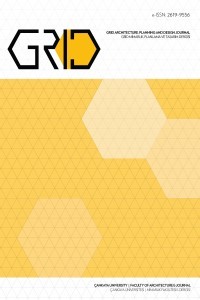Üçüncü biçimcilik: İstanbul'daki Arter binası üzerine bir inceleme
Arter, Mimari biçimcilik, Mimari özerklik, Yeni mimari pragmatizm, Mutlak mimari
The third formalism: A study on the Arter building in İstanbul
Architectural formalism, Architectural autonomy, New architectural pragmatism, Absolute architecture, Arter,
___
- Akalın, E. Ö. (2003). Kentsel Dönüşümün Uygulanabilinirliğine Yönelik Bir Alan Araştırması, Dolapdere Örneği. Yüksek Lisans Tezi, İstanbul Teknik Üniversitesi, İstanbul.
- Anay, H. (2012). Mimari Biçimcilik. Eskişehir: Osmangazi Üniversitesi Yayınları.
- Anderson, S. (2002). Quasi-Autonomy in Architecture: The Search for an ‘In-between’. Perspecta 33, 31-34.
- Aureli, P. V. (2013). Means to an End: The Rise and Fall of the Architectural Project of the City. In P. V. Aureli (Ed.), The City as a Project (pp. 14-38). Berlin: Ruby Press.
- Aureli, P. V. (2011). The Possibility of an Absolute Architecture. Cambridge, MA: The MIT Press.
- Aureli, P. V. (2009). More and More and Less and Less: Notes Toward a History of Nonfigurative Architecture. Log 16, 7-18.
- Aureli, P. V. (2008). The Project of Autonomy: Politics and Architecture within and against Capitalism. New York: The Temple Hoyne Buell Center for the Study of American Architecture, with Princeton Architectural Press.
- Aureli, P. V. (2004). Architecture and Content: Who’s Afraid of the Form-Object? Log 3, 29-36.
- Baird, G. (2007). “Criticality” and Its Discontents. In W. S. Saunders (Ed.), The New Architectural Pragmatism: A Harvard Design Magazine Reader (pp. 136-149). Minneapolis: University of Minnesota Press.
- Baltacı, G. & Karataş, B. (2021). Tarlabaşı-Dolapdere Kadın Odak Grup Görüşmeleri Raporu. Erişim tarihi: 28.06.2022. https://sehirplanlama.ibb.istanbul/wp-content/uploads/2022/01/BeyogluSenin_Tarlabasi-Dolapdere-Kadin-Odak-Grup-Gorusmeleri-Raporu.pdf
- Bingöl, Ö. (2007). Mimarlıkta Tip ve Tipoloji Kavramı. Doktora Tezi, Mimar Sinan Güzel Sanatlar Üniversitesi, İstanbul.
- Boullée, É-L. (1976). Architecture: Essay on Art. In H. Rosenau (Ed.), Boullée & Visionary Architecture (pp. 81-116). London: Academy Editions.
- Corbo, S. (2014). From Formalism to Weak Form: the Architecture and Philosophy of Peter Eisenman. London: Routledge.
- Deborah, F. (1996). The Oppositions of Postmodern Tectonics. ANY 14, 48-57.
- Eisenman, P. (2014). Aspects of Modernism: Maison Dom-ino and the Self-referential Sign. Log 30, 139-151.
- Eisenman, P. (2008). Foreword: [Bracket]ing History. In Anthony Vidler, Histories of the Immediate Present: Inventing Architectural Modernism (p. viii). Cambridge, MA: The MIT Press.
- Eisenman, P. (2000). Autonomy and the Will to the Critical. Assemblages 41, 90-91.
- Eisenman, P. (1984). The End of the Classical: The End of the Beginning, the End of the End. Perspecta 21, 154-173.
- Ergün, S. (2022). Galerilerden Müzelere Mekanlar ve Alanlar: İstanbul Dolapdere Semtinde Sanatsal Soylulaştırma. Yüksek Lisans Tezi, Hacettepe Üniversitesi, Ankara.
- Forty, A. (2004). Words and Buildings: A Vocabulary of Modern Architecture. London: Thames & Hudson.
- Hays, M.K. (1984). Critical Architecture: Between Culture and Form. Perspecta 21, 14-29.
- Kaufmann, E. (1952). Three Revolutionary Architects, Boullée, Ledoux, and Lequeu. American Philosophical Society 42(3), 431-564.
- Komez. Daglioglu, E. (2020). Reclaiming Context: Between Autonomy and Engagement. In C. J. Burns & A. Kahn (Eds.), Site Matters: Strategies for Uncertainty Through Planning and Design (pp. 26-37). New York: Routledge.
- Lefebvre, P. (2017). What Difference Could Pragmatism Have Made? From Architectural Effects to Architecture’s Consequences. Footprint 20, 23-36.
- Martin, R. (2007). Critical of What? Toward a Utopian Realism. In W. S. Saunders (Ed.), The New Architectural Pragmatism: A Harvard Design Magazine Reader (pp. 150-161). Minneapolis: University of Minnesota Press.
- Ockman, J. (2000). The Pragmatist Imagination: Thinking About “Things in the Making”. New York: Princeton Architectural Press.
- Osman, M., Ruedig, A., Seidel, M. & Tilney, L. (2002). Editors’ Statement. Perspecta 33, 7.
- Pintos, P. (2020). Arter Museum/Grimshaw. ArchDaily. Retrieved February 24, 2022, from https://www.archdaily.com/943460/arter-museum-grimshaw
- Rowe, C. &. Koetter, F. (1978). Collage City. Cambridge, MA: The MIT Press.
- Sennett, R. (2019). The Open City. Lotus International 168, 117-129.
- Somol, R. & Whiting, S. (2002). Notes Around the Doppler Effect and Other Moods of Modernism. Perspecta 33, 72-77.
- Spencer, D. (2016). Less than Enough: A Critique of Aureli. This Thing Called Theory (pp. 283-291). London and New York: Routledge.
- Toorn, R. V. (2007). No More Dreams? The Passion for Reality in Recent Dutch Architecture… and Its Limitations. The New Architectural Pragmatism: A Harvard Design Magazine Reader (pp. 54-74). Minneapolis: University of Minnesota Press.
- Utkan Özden, H. (2020). Çağdaş Sanat Müzelerinin Kent Kültürüne Etkisi: Tate Modern ve Arter Örneği. UNIMUSEUM 3 (2), 75-81.
- Vidler, A. (2008). Histories of the Immediate Present: Inventing Architectural Modernism. Cambridge, MA: The MIT Press.
- Vidler, A. (2002). The Ledoux Effect: Emil Kaufmann and the Claims of Kantian Autonomy. Perspecta 33, 16-29.
- Vidler, A. (1998). The Third Typology. In K. Hays (Ed.), Oppositions Reader: Selected Readings from a Journal for Ideas and Criticism in Architecture 1973-1984 (pp. 13-16). New York: Princeton Architectural Press.
- Yayın Aralığı: Yılda 2 Sayı
- Başlangıç: 2017
- Yayıncı: Çankaya Üniversitesi
Merve TUNA KAYILI, Caner YETİŞ
Kent deneyimi ve belleğin imgelerle dönüşümü
Fatma KOLSAL, Feran Özge GÜVEN ULUSOY
Muammer YAMAN, Zeynep Yeşim İLERİSOY
Modern mimarinin sağlık ilkelerini Güzelyurt'taki örnekleri üzerinden okumak
Feriha URFALI DOĞU, Lerzan ARAS
Üçüncü biçimcilik: İstanbul'daki Arter binası üzerine bir inceleme
Umut Bora ŞAHİN, Esin KÖMEZ DAĞLIOĞLU
Sıva türünün tarihi camilerin özgün akustik karakterlerinin korunmasına etkileri
Fatma YELKENCİ SERT, Özgül YILMAZ KARAMAN
Karantina yapılanmaları: Klazomen tahaffuzhanesi örneği
21. Yüzyılda medyanın mimarlığın kuramsal söylemindeki hareketlilikleri
15. ve 19. yüzyıllar arası tarihi kartografik malzemelerde Bodrum Halikarnas tasviri
